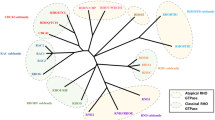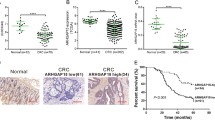Abstract
Rho family GTPases play a pivotal role in the regulation of numerous cellular functions associated with malignant transformation and metastasis. To evaluate the role of these GTPases in colorectal cancer, the protein expression levels and activities of these proteins in matched sets of tumor and non-tumor tissues of surgical specimens were analyzed. The relationship between the protein levels and activities in tumor tissues to the clinicopathological features was also assessed. The expression levels of RhoA, active RhoA, Rac1, and active Rac1 in tumor tissues were higher than in normal tissues. The amounts of active RhoA protein in primary tumors correlated with lymph nodes metastasis. No relationship was noted between the protein expression levels and other clinicopathological findings. These findings suggest that the Rho family small GTPases are related to malignant transformation and progression of colorectal cancer and the activation of RhoA is associated with the lymph node metastasis.
Similar content being viewed by others
Avoid common mistakes on your manuscript.
Introduction
Colorectal cancer is one of the most common malignant tumors in the world and the third leading cause of cancer death in Japan. The most important factor that affects the prognosis is the presence and development of metastasis. Cancer metastasis is a complicated multistep cascade that involves cancer-cell detachment from the primary site, invasion, and attachment to the target metastatic organ. In this cascade, Rho family small GTPases are suggested to play important roles [1]. In these Rho-dependent processes, cell motility and invasion are required.
Recently, it has been reported that the Rho family small GTPases act as intracellular molecular switches that regulate cell motility [2]. In malignant tumors, Rho family small GTPases are thought to play important roles in the process of tumor progression and metastasis [3–7]. Small GTPases are known to exist in two states: the inactive-GDP-bound form and the active-GTP-bound form which can perform its functions [8]. Although some clinical reports indicate that levels of Rho family proteins correlate with tumor progression and metastasis, little is known about the activities of Rho family proteins in colorectal cancer [3–7].
In the present study, we investigated the activities and expression levels of Rho family proteins including, RhoA, and Rac1 in advanced colorectal cancer, and evaluated the relationship between Rho family proteins and clinicopathological findings of advanced colorectal cancer.
Materials and methods
Patients and tissue preparation
Surgical specimens of advanced colorectal cancer obtained from 27 consecutive Japanese patients with newly diagnosed primary colorectal cancer between October 2001 and April 2005 were examined. The patients consisted of 19 men and 8 women, aged 35–81 years, with a mean age of 64.5 years. Normal tissues were dissected sufficiently away from the tumors and only mucosal tissues were obtained to avoid the contamination of stromal tissue. The study was conducted in accordance with the Helsinki declaration. The university ethics committee approved this study and all patients provided written informed consent.
Western blotting
Proteins of tumor and nontumor tissues were extracted in lysis buffer (50 mM Tris–HCl pH 7.5, 25 mM NaCl, 1% Nonidet P-40, and a protease inhibitor mixture) at 4°C for 30 min. The lysate was obtained by centrifugation at 12,000 × g for 5 min, and the supernatants were transferred to fresh tubes. Fifty micrograms of cytosolic proteins were subjected to sodium dodecyl sulfate (SDS) polyacrylamide gel electrophoresis (12.5%). After electrophoresis, the proteins were transferred to polyvinylidene fluoride (PVDF) membranes (Bio-Rad, Hercules, USA). The expression levels of RhoA and Rac1 proteins were analyzed using specific antibodies (RhoA; sc-179, Santa Cruz, Rac1; clone102, BD BioScience, β-tubulin; sc-9104, Santa Cruz). After incubation with peroxidase-conjugated second antibodies, proteins were visualized by chemiluminescence. The blotted membranes were scanned densitometrically using a Fuji LAS1000 Plus charge-coupled device (CCD) camera (Fuji Photo Film Co., Japan) and analyzed with Image Gauge software (Fujifilm). To quantify protein levels, the relative amounts of RhoA and Rac1 were related to those of the corresponding normal tissues, which were set to a value of 1.0, by densitometrical analysis as described previously [4]. The mean values from three sections of tumor and nontumor tissues were calculated.
Pull-down assay
The levels of the active small GTPases RhoA and Rac1 in the GTP-bound forms were measured with pull-down assays. The pull-down assays were carried out as previously described [9]. Briefly, GTP-bound RhoA or GTP-bound Rac1 GTPases were precipitated by mDia or PAK (p21-activated kinase-1), respectively, each fused to glutathione-S transferase precoupled to glutathione-Sepharose beads. These GTP-bound fractions were detected by Western blot analysis, as described above.
Statistical analysis
Data are expressed as mean ± standard deviation (SD) unless otherwise noted.
Results of Western blotting were statistically analyzed using the Mann–Whitney U test. The relationship between Rho protein expression and clinicopathological factors were analyzed using the χ 2 test and Student’s t test. Data were analyzed using the Stat View software package (Abacus Concepts, Inc.), and the findings were considered significant for P values < 0.05.
Results
Expression of RhoA and Rac1 is increased in colorectal cancer
To test whether the expression of Rho family proteins were altered in advanced colorectal cancer, we analyzed the expression levels of these small GTPases with Western blot analysis. As shown by the representative cases in Fig. 1A, protein expression of RhoA and Rac1 was detected in both tumors and normal tissues. The amounts of these proteins were significantly higher in cancer tissues, 3.49 ± 0.49 (RhoA) and 2.18 ± 0.26 (Rac1), ompared to normal samples, defined as 1.0 (P < 0.001; Fig. 1B).
Expression and activity levels of RhoA and Rac1 proteins in colorectal cancer. (A) Each number represents a case of colorectal cancer and adjacent nontumor tissue. N, normal tissue; T, tumor. (B) Histogram of relative expression of RhoA and Rac1. Both of the proteins were overexpressed in tumor tissues. Bars: mean ± SE. (C) Histogram of relative activity of RhoA and Rac1. Both of the proteins were activated in tumor tissues. Bars: mean ± SE
RhoA and Rac1 are activated in colorectal cancer
To examine whether the observed increase in protein expressions were accompanied by activities of these proteins, pull-down assays were performed. As shown in Fig. 1, activation of RhoA and Rac1 in cancer tissues was significantly higher than in the normal controls, with means of 2.37 ± 0.48 and 2.74 ± 0.49, respectively (P < 0.001; Fig. 1C).
Activation of RhoA is correlated with lymph node metastasis
To determine the role of Rho family GTPases expression and activation in colorectal cancer, we examined the correlation of RhoA/Rac1 expression and activation with the clinical features. The expression levels of RhoA and Rac1 proteins had no correlation with maximum tumor size (Fig. 2), depth of cancer invasion (Fig. 3), histological grade or blood levels of carcinoembryonic antigen (CEA, data not shown). The expression and activation of RhoA tended to correlate with the presence of vascular invasion (Fig. 4). However, this did not reach statistical significance, possibly as the result of the limited number of patients. The expression of RhoA and the activity of this protein were correlated with the presence of lymph node metastasis (Fig. 5; P < 0.001). The mean value for the active RhoA in the tumor samples was 2.37 ± 1.48. Cases were divided into two groups, with activity above and below this mean, respectively. As shown in Table 1, the incidence of lymph node metastasis in the high-activity group (9 of 10, 90%) was significantly higher (P < 0.001) than that in the low-activity group (2 of 17, 12%).
Discussion
The Rho family small GTPases act as intracellular molecular switches that transduce signals from extracellular stimuli to the actin cytoskeleton and the nucleus, and regulate cell migration and malignant transformation [2]. In the present study, we investigated the expression of Rho family small GTPases in colorectal cancer. The expression of RhoA and Rac1 was increased in cancer tissues when compared with normal mucosa. These results were consistent with the previous reports examining Rho and Rac in various cancers [4–7, 10]. Our results also showed that the activity of RhoA and Rac1 was upregulated in cancer tissues. To our knowledge, this is the first report of the relationship between the activities of Rho family proteins and colorectal cancer.
Since activation of RhoA and Rac1 was observed in colon cancer, we hypothesized that the activities of these small GTPases might be a marker of malignancy and progression of colorectal cancer. To provide support this hypothesis, we evaluated the relationship between the activities of these proteins and clinicopathological factors. Interestingly, activation of RhoA protein in tumors with lymph node involvement were greater than in those that did not metastasize. These results suggest that the activation of RhoA may play an important role in lymph node metastasis. There are several possible mechanisms. First, since RhoA is a key regulator of cell motility, RhoA might upregulate tumor-cell motility. Second, in gastric cancer, Rho-mediated NFκB activation confers resistance to apoptosis [11]. It is possible that the same mechanism (as in gastric cancer) is acting in colorectal cancer. Third, Vasiliev et al. recently reported that the overexpression of Rho leads to mitosis-associated detachment of cells from epithelial sheets [12]. The activation of RhoA might cause the detachment of primary tumor cells in colorectal cancer.
Although many diagnostic advances have occurred, it is still difficult to diagnose lymph nodes metastasis accurately in colorectal cancer [13–15]. The assessment of RhoA activity may be a helpful marker and indication for the presence of lymph nodes metastasis and guidance of subsequent therapy.
References
Quigley JP, Armstrong PB (1998) Tumor cell intravasation alu-cidated: the chick embryo opens the window. Cell 94:281–284
Hall A (1998) Rho GTPases and the actin cytoskeleton. Science 279:509–514
Bouzahzah B et al (2001) Rho family GTPases regulate mammary epithelium cell growth and metastasis through distinguishable pathways. Mol Med 7:816–830
Fritz G, Just I, Kaina B (1999) Rho GTPases are over-expressed in human tumors. Int J Cancer 81:682–687
Suwa H et al (1998) Overexpression of the rhoC gene correlates with progression of ductal adenocarcinoma of the pancreas. Br J Cancer 77:147–152
Kamai T et al (2003) Significant association of Rho/ROCK pathway with invasion and metastasis of bladder cancer. Clin Cancer Res 9:2632–2641
Wang W, Yang LY, Yang ZL, Huang GW, Lu WQ (2003) Expression and significance of RhoC gene in hepatocellular carcinoma. World J Gastroenterol 9:1950–1953
Boguski MS, McCormick F (1993) Proteins regulating Ras and its relatives. Nature 366:643–654
Kimura K, Tsuji T, Takada Y, Miki T, Narumiya S (2000) Accumulation of GTP-bound RhoA during cytokinesis and a critical role of ECT2 in this accumulation. J Biol Chem 275:17233–17236
Schnelzer A et al (2000) Rac1 in human breast cancer: overexpression, mutation analysis, and characterization of a new isoform, Rac1b. Oncogene 19:3013–3020
Liu CA, Wang MJ, Chi CW, Wu CW, Chen JY (2004) Rho/Rhotekin-mediated NF-kappaB activation confers resistance to apoptosis. Oncogene 23(54):8731–8742
Vasiliev JM, Omelchenko T, Gelfand IM, Feder HH, Bonder EM (2004) Rho overexpression leads to mitosis-associated detachment of cells from epithelial sheets: a link to the mechanism of cancer dissemination. Proc Natl Acad Sci USA 101:12526–12530
McNicholas MM et al (1994) Magnetic resonance imaging of rectal carcinoma: a prospective study. Br J Surg 81:911–914
Saitoh N et al (1986) Evaluation of echographic diagnosis of rectal cancer using intrarectal ultrasonic examination. Dis Colon Rectum 29:234–242
Beynon J et al (1989) Preoperative assessment of mesorectal lymph node involvement in rectal cancer. Br J Surg 76:276–279
Acknowledgements
We wish to thank S. Narumiya for pGEX-4T-1-mouse mDia RBD; T. Sato for pGEX-PAK-CRIB. We also thank T. Umemiya and M. Azuma for technical assistance.
Author information
Authors and Affiliations
Corresponding author
Rights and permissions
About this article
Cite this article
Takami, Y., Higashi, M., Kumagai, S. et al. The Activity of RhoA is Correlated with Lymph Node Metastasis in Human Colorectal Cancer. Dig Dis Sci 53, 467–473 (2008). https://doi.org/10.1007/s10620-007-9887-0
Received:
Accepted:
Published:
Issue Date:
DOI: https://doi.org/10.1007/s10620-007-9887-0









